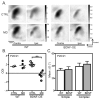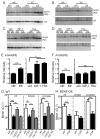Environmental enrichment rescues binocular matching of orientation preference in mice that have a precocious critical period
- PMID: 24012279
- PMCID: PMC3796011
- DOI: 10.1016/j.neuron.2013.07.023
Environmental enrichment rescues binocular matching of orientation preference in mice that have a precocious critical period
Abstract
Experience shapes neural circuits during critical periods in early life. The timing of critical periods is regulated by both genetics and the environment. Here we study the functional significance of such temporal regulations in the mouse primary visual cortex, where critical period plasticity drives binocular matching of orientation preference. We find that the binocular matching is permanently disrupted in mice that have a precocious critical period due to genetically enhanced inhibition. The disruption is specific to one type of neuron, the complex cells, which, as we reveal, normally match after the simple cells. Early environmental enrichment completely rescues the deficit by inducing histone acetylation and consequently advancing the matching process to coincide with the precocious plasticity. Our experiments thus demonstrate that the proper timing of the critical period is essential for establishing normal binocularity and the detrimental impact of its genetic misregulation can be ameliorated by environmental manipulations via epigenetic mechanisms.
Copyright © 2013 Elsevier Inc. All rights reserved.
Figures






Similar articles
-
Environmental Enrichment Rescues Binocular Matching of Orientation Preference in the Mouse Visual Cortex.J Neurosci. 2017 Jun 14;37(24):5822-5833. doi: 10.1523/JNEUROSCI.3534-16.2017. Epub 2017 May 12. J Neurosci. 2017. PMID: 28500220 Free PMC article.
-
Critical period plasticity matches binocular orientation preference in the visual cortex.Neuron. 2010 Jan 28;65(2):246-56. doi: 10.1016/j.neuron.2010.01.002. Neuron. 2010. PMID: 20152130 Free PMC article.
-
Binocular input coincidence mediates critical period plasticity in the mouse primary visual cortex.J Neurosci. 2014 Feb 19;34(8):2940-55. doi: 10.1523/JNEUROSCI.2640-13.2014. J Neurosci. 2014. PMID: 24553935 Free PMC article.
-
Circuitry Underlying Experience-Dependent Plasticity in the Mouse Visual System.Neuron. 2020 Apr 8;106(1):21-36. doi: 10.1016/j.neuron.2020.01.031. Neuron. 2020. PMID: 32272065 Free PMC article. Review.
-
Mechanisms of visual plasticity: Hebb synapses, NMDA receptors, and beyond.Physiol Rev. 1991 Apr;71(2):587-615. doi: 10.1152/physrev.1991.71.2.587. Physiol Rev. 1991. PMID: 1826058 Review. No abstract available.
Cited by
-
Experience-Dependent Development and Maintenance of Binocular Neurons in the Mouse Visual Cortex.Cell Rep. 2020 Feb 11;30(6):1982-1994.e4. doi: 10.1016/j.celrep.2020.01.031. Cell Rep. 2020. PMID: 32049025 Free PMC article.
-
GABAergic synapses: their plasticity and role in sensory cortex.Front Cell Neurosci. 2014 Mar 26;8:91. doi: 10.3389/fncel.2014.00091. eCollection 2014. Front Cell Neurosci. 2014. PMID: 24723851 Free PMC article. Review.
-
Large-scale synaptic dynamics drive the reconstruction of binocular circuits in mouse visual cortex.Nat Commun. 2025 Jul 1;16(1):5810. doi: 10.1038/s41467-025-60825-y. Nat Commun. 2025. PMID: 40593694 Free PMC article.
-
Neural circuits for binocular vision: Ocular dominance, interocular matching, and disparity selectivity.Front Neural Circuits. 2023 Feb 15;17:1084027. doi: 10.3389/fncir.2023.1084027. eCollection 2023. Front Neural Circuits. 2023. PMID: 36874946 Free PMC article. Review.
-
MeCP2 regulates the timing of critical period plasticity that shapes functional connectivity in primary visual cortex.Proc Natl Acad Sci U S A. 2015 Aug 25;112(34):E4782-91. doi: 10.1073/pnas.1506499112. Epub 2015 Aug 10. Proc Natl Acad Sci U S A. 2015. PMID: 26261347 Free PMC article.
References
-
- Alonso JM, Martinez LM. Functional connectivity between simple cells and complex cells in cat striate cortex. Nat Neurosci. 1998;1:395–403. - PubMed
-
- Baroncelli L, Sale A, Viegi A, Maya Vetencourt JF, De Pasquale R, Baldini S, Maffei L. Experience-dependent reactivation of ocular dominance plasticity in the adult visual cortex. Exp Neurol. 2010;226:100–109. - PubMed
-
- Begenisic T, Spolidoro M, Braschi C, Baroncelli L, Milanese M, Pietra G, Fabbri ME, Bonanno G, Cioni G, Maffei L, Sale A. Environmental enrichment decreases GABAergic inhibition and improves cognitive abilities, synaptic plasticity, and visual functions in a mouse model of Down syndrome. Front Cell Neurosci. 2011;5:29. - PMC - PubMed
Publication types
MeSH terms
Grants and funding
LinkOut - more resources
Full Text Sources
Other Literature Sources
Molecular Biology Databases

